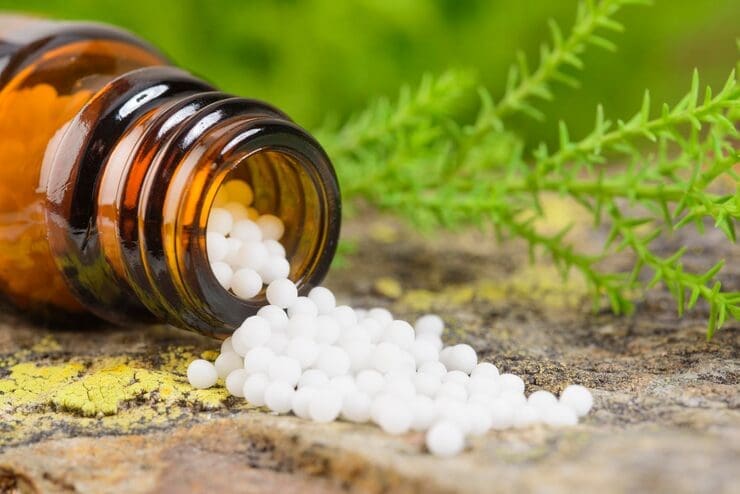
Arsenicum iodatum
Latin name: Arsenicum iodatum
Short name: Ars-i
Common name: Arsenic Iodide | Arsenious Iodide | Iodide of Arsenic | Arsenic Triiodide | Arsenic(III) Iodide
Primary miasm: Syphilitic Secondary miasm(s): Tubercular, Sycotic
Kingdom: Minerals
Family: Inorganic compound
- Symptomatology
- Remedy Information
- Differentiation & Application
Arsenicum iodatum is a chemical compound (AsI₃), prepared by combining elemental arsenic with iodine. It crystallises as red or orange-red solids and is soluble in alcohol but decomposes in water. In homeopathy, it is prepared by trituration, carrying the combined properties of arsenic and iodine: the deep constitutional action of arsenic on metabolism, nutrition, and mucous membranes, and the glandular, catarrhal, and fibrotic tendencies of iodine.
Historically used in very dilute forms in veterinary medicine for skin diseases and as a tonic. In toxicology, it is highly poisonous, with both arsenic and iodine effects—gastrointestinal corrosion, cardiovascular collapse, and severe metabolic disturbance. Not used in modern orthodox medicine due to toxicity.
Introduced into homeopathic practice in the mid-19th century; proving data is largely clinical, expanded by Farrington, Clarke, and later Boericke, with emphasis on chronic inflammatory states, cachexia, and catarrh.
- Respiratory mucosa (especially chronic catarrh and ulcerations).
- Skin (chronic eczema, psoriasis, ulcerations, exfoliations).
- Lymphatic glands (enlargement, induration).
- Nutrition and metabolism (marasmus, wasting diseases).
- Cardiovascular system (weakness, palpitations in chronic states).
- Mucous membranes of digestive tract (chronic gastritis, ulcer tendency).
- Warmth and warm surroundings, though less marked than pure Arsenicum album.
- Fresh air in some chronic catarrhal states.
- Gentle movement during exhaustion phases.
- Improvement in summer in some skin conditions.
- Cold, damp air.
- Night, particularly after midnight.
- Change of season, especially spring and autumn.
- Physical exertion when weakened.
- Suppressed discharges (nasal, skin) leading to internal aggravations.
- Arsenicum album – More anxiety, chilliness, and prostration; less glandular and catarrhal action.
- Iodium – More pronounced hyperactivity and ravenous appetite; less burning ulceration.
- Kali bichromicum – Catarrh with thick, stringy mucus; less cachexia.
- Sulphur iodatum – Skin conditions with glandular swellings but more heat and itching without ulcer depth.
- Complementary: Iodium, Tuberculinum.
- Antidotes: China, Nux vomica in drug effects.
- Follows well: Calcarea phosphorica in wasting states.
The essence of Arsenicum iodatum is the burning, wasting ulceration of mucous membranes and skin, accompanied by persistent catarrh and glandular induration, in a constitution tending toward decline. It marries the deep debility and burning pains of arsenic with the glandular, fibrotic, and metabolic disturbances of iodine.
Particularly valuable in chronic bronchitis of the aged, persistent nasal catarrh with ulceration, and skin diseases with burning, acrid discharges. Often useful in the treatment of tuberculosis, especially where weight loss is rapid despite good appetite. Recommended in 3x to 6x triturations for long-term catarrhal states, higher potencies for constitutional effects.
Mind
- Anxiety with restlessness.
- Despondency in chronic disease.
Head
- Burning in forehead.
- Frontal sinus pain with catarrh.
Eyes
- Burning, excoriating lachrymation.
- Chronic conjunctivitis.
Stomach
- Appetite increased yet loses weight.
- Burning gastric pain.
Skin
- Chronic eczema with thick crusts.
- Ulcerations with acrid discharge.
Extremities
- Weakness with muscle wasting.
- Restlessness of legs at night.
Generalities
- Rapid emaciation.
- Burning pains in mucous membranes.
Clarke – A Dictionary of Practical Materia Medica: Chronic catarrh, ulcerations, wasting states.
Farrington – Clinical Materia Medica: Tubercular constitutions, burning ulcerations, glandular involvement.
Boericke – Pocket Manual of Homœopathic Materia Medica: Concise keynote symptoms.
Allen, T. F. – Encyclopaedia of Pure Materia Medica: Toxicological and clinical data.
Hering – The Guiding Symptoms: Chronic respiratory and skin effects.
